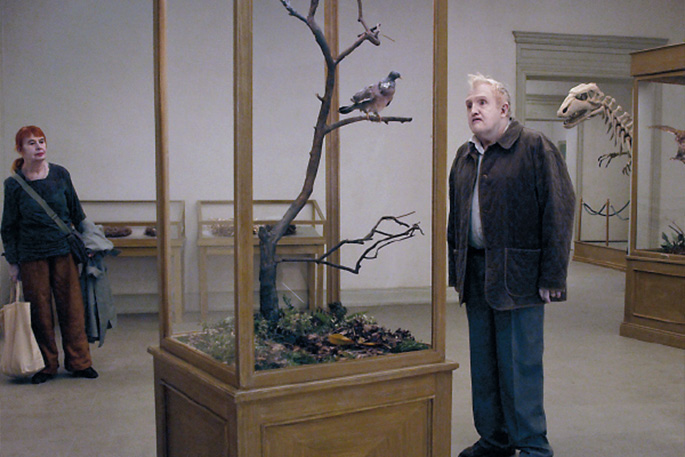Even if a new Roy Andersson film wasn’t catnip to a film critic, a title like A Pigeon Sat On A Branch Reflecting On Existence is determined to call attention to itself. But calling attention to themselves isn’t something Andersson’s films actively do. APSOABROE can’t help it; having won the Golden Lion at the Venice Film Festival is bound to up your visibility. That said, the film is very much of a piece with its trilogy precedents, Songs From The Second Floor and You, The Living. Anyone expecting (or hoping for) a change from the Swedish director had better turn back. Andersson’s up to his old tricks, whether you like it or not.”
The film opens in a natural history museum, with a typically-beleaguered Andersson-ian onlooker gawping at a stuffed pigeon. Yep, good old-fashioned self-reflexivity and introspection are firmly bolted in place. After the title card come three mini-vignettes depicting various experiences with death. Even more than his previous two films, Andersson’s latest boasts a Bergman-esque fascination with death. The grey walls feel ever greyer; the deep focus shots seem deeper. Characters are pulled this way and that by forces they cannot seem to control. A participant in a dance class is repeatedly groped by his randy dance teacher, and all he can do is push her away, only for her to try it again. Each time he stops her we think we’re done, but back she comes, and with her a wave of laughter. Despite the insistent misery heaped on so many of its characters, a repeated punchline is the cheery sign-off, “I’m happy to hear you’re doing fine.” Andersson’s bitter irony brings an R.E.M. song about Armaggeddon to mind (i.e. no bad thing).
Andersson’s grey worlds are populated by grey souls, perhaps not people but something approximate. His caricatures are once again put through the emotional wringer in one vignette after another. Carrying us through these travails are Jonathan (Holger Andersson) and Sam (Nils Westblom), a pair of travelling salesmen hawking novelty gags like masks and vampire teeth, albeit without much success. For comedies, Andersson’s films succeed primarily in showing the inherent sadness in the human condition. They’re giddy, elevated burlesque pieces, but the futility at the heart of these character’s exploits is universally recognisable. The dance teacher can’t seduce her pupil, Jonathan and Sam can’t make a sale and everyone else is doing fine, until they’re not. Every line and droopy gesture is borne with clarity; Andersson is nothing if not deliberate. Each vignette can take up to a month to shoot, such is his precision. As technical exercises, this trilogy’s dearth and daring merit great admiration.
Of the trilogy, APSOABROE is the most ambitious, with Andersson blending settings and timespans within sketches. A modern pub suddenly finds itself playing host to a Napoleonic army, whilst a waitress recalls her WWII days spent taking payment for beer in aggressive kisses. It’s all very odd, but is it funny? Well, to a point. Much of Andersson’s humour is best filed under ‘WTF.’ He effortlessly merges the banal and the barmy, and the effect can’t but cause a reaction, mostly involving the three letters just mentioned. However, as time goes on, and certain gags and characters raise their heads again, repetition begins to set in, and the joke isn’t going to be as funny the second time around. Perhaps Andersson knows this, and thus decides to throw in some real curveballs. Scenes involving a laboratory monkey and African slaves flirt with controversy. But then we revisit an old gag that one might have assumed was put to bed. The pub-invading soldiers were preparing for battle, so now we have to see them return from the front bloodied, limping and occasionally dead. It gets to a stage where the necessity of it all comes into question. We’ve had the laugh, and we get the subtext (provided there’s a subtext to be got), just leave well enough alone!
APSOABROE is less than ten minutes longer than the previous installments in Andersson’s trilogy, but it feels more drawn out. This feeling is mercifully balanced by a concurrent increase in scope, and some uproarious scenes that can only be described as Andersson-ian. If the laughter were being undermined by that makeup-caked sadness that defines the Swede’s work, it’d be a different story, if not a different film. This is simply a case of a writer-director not knowing when to say when. But it’s good to hear he’s doing fine.

